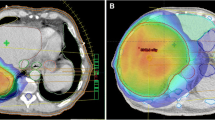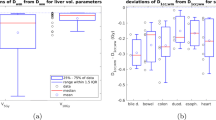Abstract
The purpose is to calculate the composite 3D biological effective dose (BED) distribution in healthy liver, when multiple lesions are treated concurrently with different hypo-fractionated schemes and stereotactic body radiation therapy, and to investigate the potential of biological based plan optimization. Two patients, each having two tumors that were treated sequentially with different treatment plans, were selected. The treatment information of both treatment plans of the patients was used and their dose matrices were exported to an in-house MATLAB software, which was used to calculate the composite BED distribution. The composite BED distributions were used to determine if the healthy liver received BED beyond tolerance. When the dose to the minimum critical volume was less than tolerance, an optimization code was used to derive the scaling factors (ScF) that should be applied to the dose matrix of each plan until the minimum critical volume of healthy liver reaches a BED close to tolerance. It was shown that for each patient, there is a margin for dose escalation regarding the doses to the individual targets. More specifically, the ScFs of the doses range between 5.6 and 99 in the first patient, whereas for the second patient, the ScFs of the optimal doses range between 12.7 and 35.6. The present study indicates that there is a significant margin for dose escalation without increasing the radiation toxicity to the healthy liver. Also, the calculation of the composite BED distribution can provide additional information that may lead to a better assessment of the liver’s tolerance to different fractionation schemes and prescribed doses as well as more clinically relevant treatment plan optimization.



Similar content being viewed by others
References
Benedict SH, Yenice KM, Followill D, Galvin JM, Hinson W, Kavanagh B et al (2010) Stereotactic body radiation therapy: the report of AAPM Task Group 101. Med Phys 37:4078–4101
Lo SS, Sahgal A, Chang EL, Mayr NA, Teh BS, Huang Z et al (2013) Serious complications associated with stereotactic ablative radiotherapy and strategies to mitigate the risk. Clin Oncol 25:378–387
Grimm J, LaCouture T, Croce R, Yeo I, Zhu Y, Xue J (2011) Dose tolerance limits and dose volume histogram evaluation for stereotactic body radiotherapy. J Appl Clin Med Phys 12:267–292
Emami B, Lyman J, Brown A, Coia L, Goitein M, Munzenrider JE et al (1991) Tolerance of normal tissue to therapeutic irradiation. Int J Radiat Oncol Biol Phys 21:109–122
Barton M (1995) Tables of equivalent dose in 2 Gy fractions: A simple application of the linear quadratic formula. Int J Radiat Oncol Biol Phys 31:371–378
Kirkpatrick JP, Meyer JJ, Marks JB (2008) The Linear-Quadratic Model Is Inappropriate to Model High Dose per Fraction Effects in Radiosurgery. Semin Radiat Oncol 18:240–243
Astrahan M (2008) Some implications of linear-quadratic-linear radiation dose-response with regard to hypofractionation. Med Phys 35:4161–4172
Guerrero M, Li X (2004) Extending the linear-quadratic model for large fraction doses pertinent to stereotactic radiotherapy. Phys Med Biol 49:4825–4835
Wang JZ, Mayr NA, Yu WTC (2007) A generalized linear-quadratic formula for high-dose-rate brachytherapy and radiosurgery. Int J Radiat Oncol Biol Phys 69:S619–S620
Park C, Papiez L, Zhang S, Story M, Timmerman R (2008) Universal survival curve and single fraction equivalent dose: Useful tools in understanding the potency of ablative radiation therapy. Int J Radiat Oncol Biol Phys 70:847–852
Atwood K, Norman A (1949) On the interpretation of multi-hit survival curves. Proc Natl Acad Sci USA 35:696–709
Carlone M, Wilkins D, Raaphorst G (2005) The modified linear quadratic model of Guerrero and Li can be derived from mechanistic basis and exhibits linear-quadratic-linear behavior. Phys Med Biol 50:L9–L15
Hall E (2011) Time, Dose, and Fractionation in Radiotherapy in Radiobiology for the Radiologist, 7th edn. Lippincott Williams & Wilkins, Philadelphia, pp 391–411
Sawrie MS, Fiveash JB, Caudell JJ (2010) Stereotactic body radiation therapy for liver metastases and primary hepatocellular carcinoma: Normal tissue tolerances and toxicity. Cancer Control 17:111–119
Schefter TE, Kavanagh BD, Timmerman RD, Cardenes HR, Baron A, Gaspar LE (2005) A phase I trial of stereotactic body radiation therapy (SBRT) for liver metastases. Int J Radiat Oncol Biol Phys 62:1371–1378
Schefter TE, Kavanagh BD, Raben D, Kane M, Chen C, Stuhr K et al (2006) A phase I/II trial of stereotactic body radiation therapy (SBRT) for lung metastases: initial report of dose escalation and early toxcitiy. Int J Radiat Oncol Biol Phys 66:S120–S127
Son SH, Jang HS, Lee H, Choi BO, Kang YN, Jang JW (2013) Determination of the α/β ratio for the normal liver on the basis of radiation-induced hepatic toxicities in patients with hepatocellular carcinoma. Radiat Oncol 8:1–8
Garcia LM, Wilkins DE, Raaphorst GP (2007) α/β ratio: a dose range dependence study. Int J Radiat Oncol Biol Phys 67:587–593
Kauweloa KI, Gutierrez AN, Stathakis S, Papanikolaou N, Mavroidis P (2016) A graphical user interface (GUI) toolkit for the calculation of three-dimensional (3D) multi-phase biological effective dose (BED) distributions including statistical analyses. Comput Methods Progr Biomed 131:1–12
Timmerman RD (2008) An overview of hypofractionation and introduction to this issue of seminars in radiation oncology. Semin Radiat Oncol 18:215–222
Fisher DR, Hendry JH (1988) Dose fractionation and hepatocyte clonogens: alpha/beta congruent to 1–2 Gy, and beta decreases with increasing delay before assay. Radiat Res 113:51–57
Brown JM, Carlson DJ, Brenner DJ (2014) The tumor radiobiology of SRS and SBRT: are more than the 5 Rs involved? Int J Radiat Biol Phys 88:254–262
Ohri N, Tomé WA, Méndez Romero A et al (2018) Local control after stereotactic body radiation therapy for liver tumors. Int J Radiat Oncol Biol Phys. https://doi.org/10.1016/j.ijrobp.2017.12.288
Doi H, Masai N, Uemoto K et al (2017) Validation of the liver mean dose in terms of the biological effective dose for the prevention of radiation-induced liver damage. Rep Pract Oncol Radiother 22:303-309
Unkelbach J, Papp D, Gaddy MR et al (2017) Spatiotemporal fractionation schemes for liver stereotactic body radiotherapy. Radiother Oncol 125:357–364
Author information
Authors and Affiliations
Corresponding author
Ethics declarations
Conflict of interest
The authors declare that there is no conflict of interest regarding the publication of this paper.
Ethical approval
All procedures performed in studies involving human participants were in accordance with the ethical standards of the Medical University of Warsaw and with the 1964 Helsinki declaration and its later amendments or comparable ethical standards.
Informed consent
Informed consent was obtained from all individual participants.
Additional information
Publisher's Note
Springer Nature remains neutral with regard to jurisdictional claims in published maps and institutional affiliations.
Rights and permissions
About this article
Cite this article
Kauweloa, K.I., Bergamo, A., Gutierrez, A.N. et al. Use of 3D biological effective dose (BED) for optimizing multi-target liver cancer treatments. Australas Phys Eng Sci Med 42, 711–718 (2019). https://doi.org/10.1007/s13246-019-00771-4
Received:
Revised:
Accepted:
Published:
Issue Date:
DOI: https://doi.org/10.1007/s13246-019-00771-4




